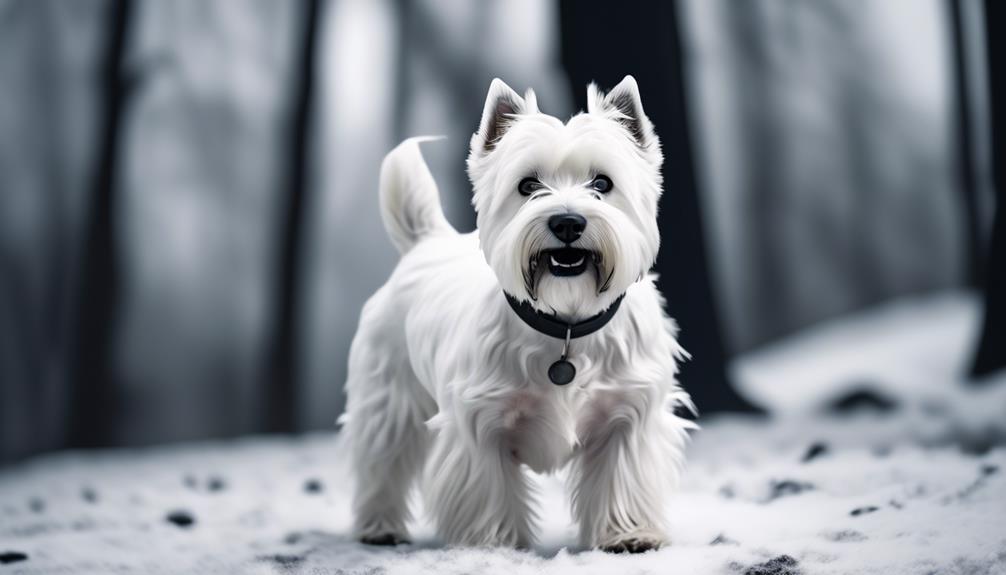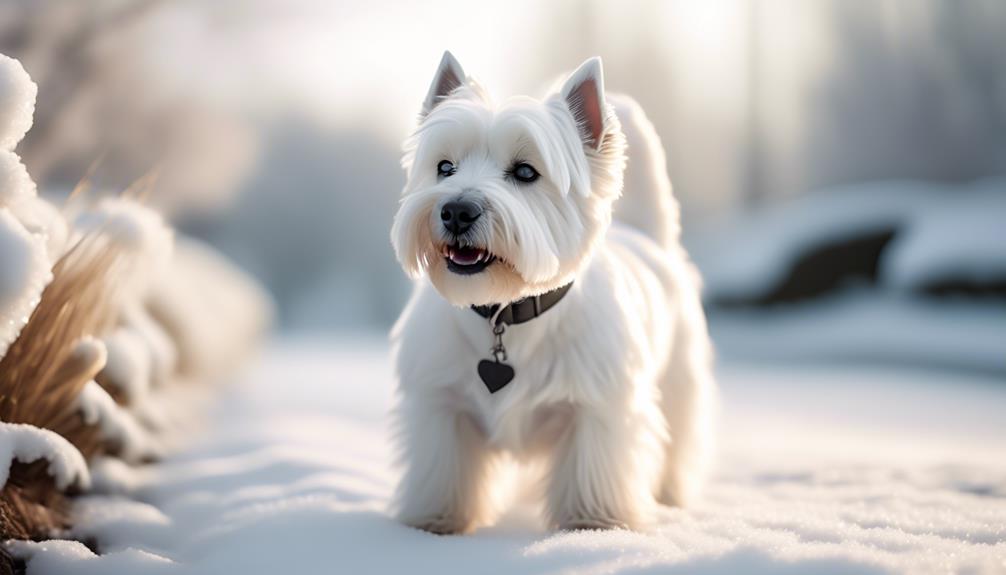
In the quaint Scottish countryside, amidst rolling hills and misty glens, there exists a small and spirited creature known as the West Highland White Terrier, or the Westie for short.
With a coat as pure as the driven snow, these little dogs have captured the hearts of many with their bold personality and confident demeanor.
But there is more to these charming canines than meets the eye, as they possess a unique adaptability and an intriguing history that begs further exploration.
Key Takeaways
- West Highland White Terriers are well-suited for apartment living due to their adaptability, low-energy levels, and polite behavior towards neighbors.
- When considering a dog for apartment living, size is not the only factor to consider. Certain larger breeds can adapt well, while some small breeds may thrive in apartments.
- It is important to prioritize qualities such as being quiet, low-energy, and displaying good manners when choosing a dog for an apartment.
- Dogs with high energy levels require significant exercise and mental stimulation, while low-energy dogs are more content with a sedentary lifestyle. Consider your own activity level and lifestyle when choosing a breed.
Origin and Size
The West Highland White Terrier, originating from Scotland, is a small breed known for its distinctive white coat and compact size. Standing at around 10-11 inches tall at the shoulder and weighing between 13-20 pounds, this terrier is perfectly suited for those seeking a small companion.
With its origins rooted in the Scottish Highlands, the Westie has a strong and sturdy build, making it an ideal choice for individuals or families living in apartments or small living spaces. Despite its small size, the West Highland White Terrier is an adaptable and low-energy breed, exhibiting polite behavior towards neighbors and displaying minimal barking tendencies.
When considering a dog for apartment living, size isn’t the sole determining factor, as certain larger breeds can also thrive in smaller spaces. However, the Westie’s quiet and well-mannered nature makes it an excellent choice for apartment dwellers seeking a compact and well-behaved canine companion.
See another Dog breed profile.
Westiepoo Dog Breed
Breed Group and Lifespan

After discussing the West Highland White Terrier’s origin and size, it’s important to now explore its breed group and lifespan.
Breed Group:
The West Highland White Terrier belongs to the Terrier breed group. Terriers are known for their energetic and feisty nature, as well as their hunting abilities. They were originally bred to control vermin and small game, making them excellent hunters.
Lifespan:
On average, West Highland White Terriers have a lifespan of 12 to 16 years. This is relatively long compared to other dog breeds. With proper care, nutrition, and regular veterinary check-ups, these dogs can live a healthy and happy life for many years.
Health Considerations:
While the West Highland White Terrier is generally a healthy breed, they’re prone to certain health conditions. Some common issues include hip dysplasia, hypothyroidism, cataracts, craniomandibular osteopathy, and pulmonary fibrosis. It’s important for potential owners to be aware of these conditions and to seek health clearances from reputable breeders.
Coat Characteristics

With a dense and harsh white coat, the West Highland White Terrier is known for its distinctive and striking appearance. This breed’s coat is a defining feature, requiring regular grooming to maintain its pristine condition. The West Highland White Terrier has a double coat, consisting of a short undercoat and a topcoat that is close to two inches long. Shedding tendencies in this breed range from low to nearly zero, making it a great choice for individuals with allergies. The coat stays fairly clean and only requires bathing when necessary. Regular brushing and trimming are necessary for grooming, with show dogs undergoing stripping about twice a year. Trimming is also needed on the feet, around the ears, and eyes. Additionally, weekly ear checks and wiping with a gentle, pH-balanced ear cleaner are recommended to keep the ears healthy.
| Coat Characteristics | |
|---|---|
| Coat Type | Double coat |
| Coat Length | Approximately two inches |
| Shedding | Low to nearly zero |
| Grooming Needs | Regular brushing and trimming |
| Ear Care | Weekly checks and wiping with gentle ear cleaner |
Adaptability to Apartment Living

Adapting well to apartment living, the West Highland White Terrier is a suitable breed for small living spaces. Here are three reasons why they excel in this environment:
- Size and Energy Level: With a compact size of 10-11 inches tall and weighing between 13-20 pounds, Westies don’t require a lot of space. They’re also a low-energy breed, making them content with a more sedentary lifestyle.
- Polite Behavior: Westies are known for their polite behavior towards neighbors. They’re generally quiet and non-excessive barkers, which is essential in an apartment setting where noise can be a concern.
- Adaptability: While size isn’t the sole determinant for apartment suitability, Westies have the adaptability to thrive in small spaces. They can be easily trained to adjust their activity levels and are generally well-suited for apartment living.
Considerations for Choosing a Dog for an Apartment

Moving on to considerations for choosing a dog for an apartment, it’s important to keep in mind certain factors that will ensure a harmonious living environment for both you and your furry companion.
Size isn’t the sole determinant when it comes to apartment living. Some larger breeds can adapt well to apartments, while certain small breeds can thrive in apartments.
Prioritizing qualities such as being quiet, low-energy, and displaying good manners is crucial.
It’s also important to consider your neighbor’s comfort. Some dogs are easier to train and more easygoing, while highly sensitive or assertive dogs may be harder for first-time owners.
Additionally, consider your own dog-owning experience, as resilient dogs can bounce back from mistakes, whereas dogs that are good for experienced owners may require more training.
Exercise Requirements and Energy Levels

Exercise requirements and energy levels vary among different dog breeds. When it comes to West Highland White Terriers, they’ve moderate exercise needs and are considered a low-energy breed. However, it’s important to note that individual dogs may have different energy levels within the breed.
Here are three key points to consider regarding exercise requirements and energy levels for West Highland White Terriers:
- Daily exercise: While they don’t require intense exercise, West Highland White Terriers still need daily walks and playtime to keep them mentally and physically stimulated.
- Mental stimulation: In addition to physical exercise, these terriers also benefit from mental stimulation, such as puzzle toys or training sessions, to prevent boredom and destructive behaviors.
- Playfulness: Westies are known for their playful nature. They enjoy interactive games and activities, making them a great choice for families or individuals who can provide them with ample playtime and interaction.
Playfulness and Interaction Needs

After discussing the exercise requirements and energy levels of West Highland White Terriers, it’s important to delve into their playfulness and interaction needs.
Westies are known for their playful and fun-loving personalities. They’ve a bold and confident nature, always ready for new experiences. These dogs love to interact with their owners and enjoy being a part of family activities. They thrive on attention and affection, and they get along well with everyone, including children and other pets.
Westies are often described as perpetual puppies due to their high potential for playfulness. They require mental and physical stimulation through playtime, interactive toys, and regular exercise. However, it’s important to note that not all Westies have the same level of playfulness, so potential owners should consider their own lifestyle and ability to provide the necessary interaction and playtime.
Personality Traits

West Highland White Terriers are known for their bold and confident personalities. They possess a unique set of traits that make them endearing to their owners and captivating to those they encounter.
Here are three key personality traits of West Highland White Terriers:
- Fearless: Despite their small stature, Westies are fearless and won’t back down from a fight. They’ve a spunky attitude that adds to their charm and makes them a force to be reckoned with.
- Adventurous: These terriers have a lively and adventurous nature. They’re always ready for new experiences and love exploring their surroundings. Their curiosity and enthusiasm make them great companions for outdoor activities.
- Friendly: Westies are friendly and get along well with everyone, including children and other pets. They’ve a loving and sociable nature, which makes them a delight to have around. Their friendly disposition makes them great family pets and beloved companions.
Common Health Conditions

Common health conditions can affect West Highland White Terriers, so it is important for owners to be aware of potential issues. Regular veterinary check-ups and proper care can help ensure the overall health of these dogs. Below is a table outlining some common health conditions that Westies may be prone to:
| Health Condition | Description |
|---|---|
| Hip Dysplasia | A condition where the hip joint doesn’t develop properly |
| Hypothyroidism | An underactive thyroid gland that can lead to various symptoms |
| Cataracts | Clouding of the lens in the eye, causing vision impairment |
| Craniomandibular Osteopathy | A condition affecting the jawbone, causing pain and difficulty eating |
| Pulmonary Fibrosis | Scarring of the lung tissue, resulting in breathing difficulties |
Coat Care and Grooming

What are the key considerations for maintaining the coat of a West Highland White Terrier?
Taking care of a West Highland White Terrier’s coat involves regular grooming and attention to detail. Here are three important factors to consider:
- Brushing and Trimming:
The West Highland White Terrier has a double coat that requires regular brushing to prevent matting and tangling. Additionally, trimming is needed on the feet, around the ears, and eyes to maintain their neat appearance.
- Bathing and Cleaning:
Although the West Highland White Terrier’s coat stays fairly clean, occasional bathing may be necessary. However, it’s important to avoid over-bathing, as it can strip the natural oils from their skin. Regular tidying and wiping down may also be needed to keep their coat sparkly white.
- Ear Care:
West Highland White Terriers are prone to ear infections, so weekly checking and cleaning of their ears is crucial. Using a gentle, pH-balanced ear cleaner and a cotton ball can help prevent infections and keep their ears healthy.
Frequently Asked Questions
Are West Highland White Terriers Good With Children?
West Highland White Terriers are generally good with children. They have a friendly and fun-loving personality, and their bold nature makes them confident around kids. However, it’s important to supervise any interactions to ensure safety for both the dog and the child.
How Often Should a West Highland White Terrier Be Groomed?
A West Highland White Terrier should be groomed regularly to maintain their double coat. This includes regular brushing, trimming, and bathing when necessary. Weekly ear cleaning is also recommended to prevent infection.
Do West Highland White Terriers Have a Strong Prey Drive?
Yes, West Highland White Terriers have a strong prey drive. They were originally bred to hunt small game, so they have a natural instinct to chase and catch prey. It’s important to provide proper training and supervision to manage their prey drive.
Are West Highland White Terriers Prone to Separation Anxiety?
Yes, West Highland White Terriers can be prone to separation anxiety. It is important to provide them with mental stimulation, exercise, and a consistent routine to help alleviate their anxiety when left alone.
Can West Highland White Terriers Be Trained to Be Off-Leash?
Yes, West Highland White Terriers can be trained to be off-leash. With consistent training and positive reinforcement, these intelligent and confident dogs can learn to obey commands and stay by their owner’s side without the need for a leash.
Conclusion
In conclusion, the West Highland White Terrier, or Westie, is a versatile and charming breed that can adapt well to apartment living. Their small size and low-energy nature make them suitable for small living spaces.
However, it’s important to consider the specific needs and energy levels of any dog when choosing one for an apartment.
With proper care and attention, the Westie can bring joy and companionship to any home.




